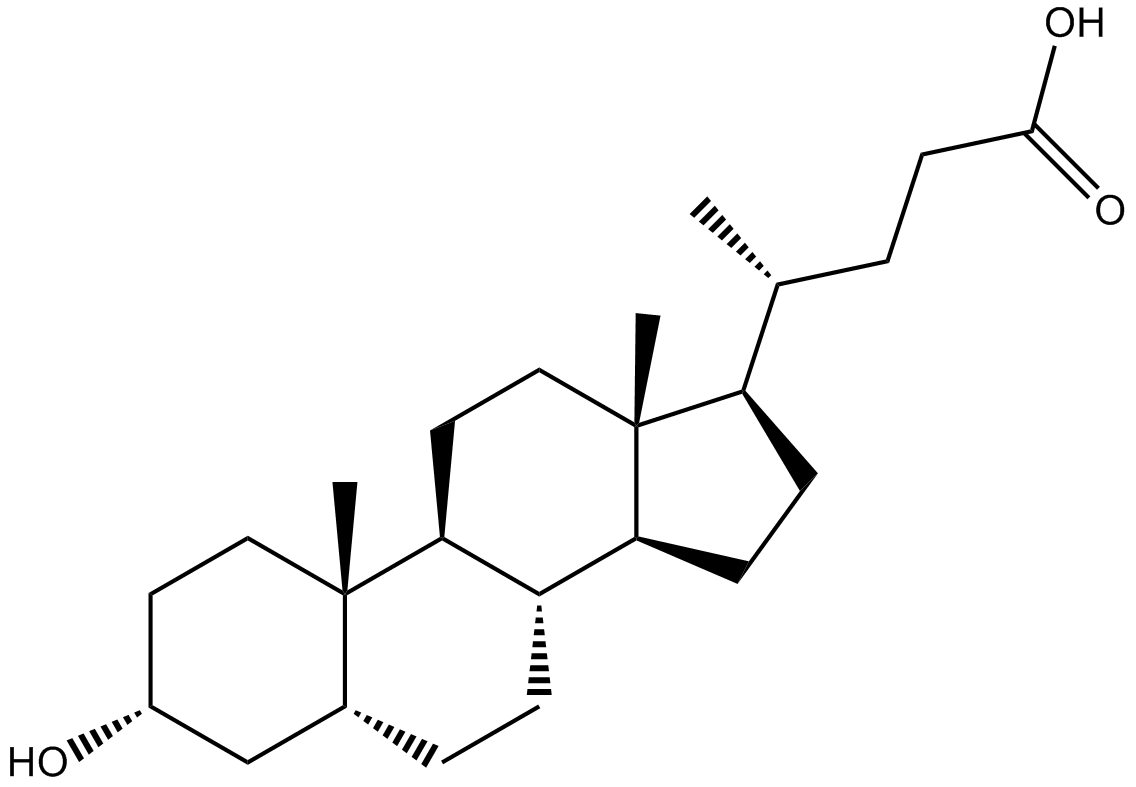All AbMole products are for research use only, cannot be used for human consumption.

Lithocholic acid is a toxic secondary bile acid, causes intrahepatic cholestasis, has tumor-promoting activity, its toxic effect can be protected after it activates the vitamin D receptor, PXR and FXR. Lithocholic acid directly binds VDR (vitamin D receptor) with Ki of 29μM, activates VDR (vitamin D receptor) 30 μM, with much more sensitivity than the other nuclear receptors (eg. PXR, FXR), and its toxic effect is thus protected. Lithocholic acid has tumor-promoting activity, inhibits mammalian DNA Polymerase β with IC50 of 15 μM.
| Molecular Weight | 376.57 |
| Formula | C24H40O3 |
| CAS Number | 434-13-9 |
| Solubility (25°C) | DMSO > 100 mg/mL Ethanol 10 mg/mL |
| Storage |
Powder -20°C 3 years ; 4°C 2 years In solvent -80°C 6 months ; -20°C 1 month |
[2] Sunil Gaikwad, et al. Lithocholic acid-based design of noncalcemic vitamin D receptor agonists
[3] Harue Sasaki, et al. Lithocholic Acid Derivatives as Potent Vitamin D Receptor Agonists
[4] Sonja Sivcev, et al. Lithocholic acid inhibits P2X2 and potentiates P2X4 receptor channel gating
| Related Ferroptosis Products |
|---|
| Cu-ATSM
Cu-ATSM is a copper complex that scavenges free radicals, inhibits lipid peroxidation and ferroptosis. Cu-ATSM exhibits antioxidant, anti-inflammatory and neuroprotective activities. |
| NCOA4-9a
NCOA4-9a (NCOA4-FTH1 inhibitor 9a) is a new ferroptosis inhibitor through disrupting the NCOA4-FTH1 protein-protein interaction, reduces intracellular ferrous iron, inhibits Erastin-induced ferroptosiswith EC50 of 0.29 μM in HT22 cells. |
| HBED
HBED is a potent iron chelator. |
| viFSP1
viFSP1 is a species-independent inhibitor of FSP1 that induces ferroptosis in FSP1-dependent cells. |
| icFSP1
icFSP1 is a potent ferroptosis suppressor protein-1 (FSP1) inhibitor. |
All AbMole products are for research use only, cannot be used for human consumption or veterinary use. We do not provide products or services to individuals. Please comply with the intended use and do not use AbMole products for any other purpose.


Products are for research use only. Not for human use. We do not sell to patients.
© Copyright 2010-2024 AbMole BioScience. All Rights Reserved.
